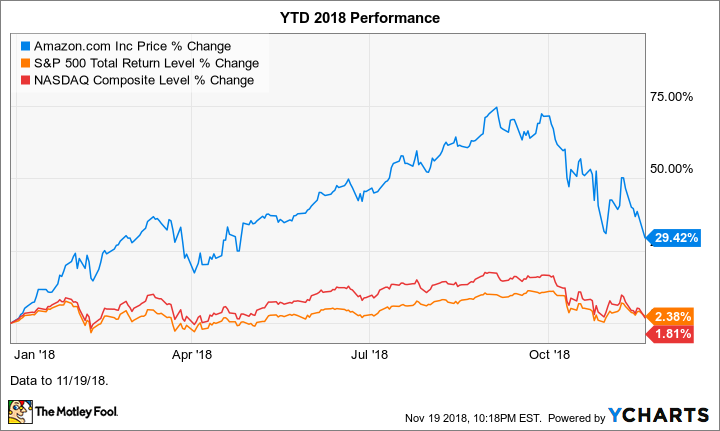Amazon.com (AMZN 1.30%) stock, currently priced at $1,512.29 per share, has gained 29.4% in 2018 through Monday, Nov. 19. That's a darn good showing from the e-commerce and cloud-computing giant considering the S&P 500 and Nasdaq indices have returned 2.4% and 1.8%, respectively, over this period.
That's the glass-half-full version.
The glass-half-empty take is that Amazon stock had been up 74.4% in 2018 through Sept. 4, when it set an all-time closing high of $2,039.51, but since early October, it has plummeted 25.9%.
Let's look at what's driven Amazon stock up -- and down -- this year.

Image source: Amazon.com.
Amazon stock's rise: Propelled by the company's strong financial performance
Amazon stock's rise throughout much of this year has been powered by the company posting strong quarterly results. Since the fourth quarter of 2017, the e-commerce titan has been crushing Wall Street's earnings estimates and its own operating income guidance.
Data by YCharts.
In the first quarter of 2018, Amazon's revenue jumped 43% year over year to $51.04 billion, operating income soared 92% to $1.9 billion, and earnings per share (EPS) skyrocketed 121% to $3.27. Amazon had guided for operating income of $300 million to $1 billion, while Wall Street was looking for EPS of $1.27. Investors were treated to more of the same when the company released second-quarter results in July. Revenue grew 39% year over year to $52.9 billion, operating income more than quadrupled to $3.0 billion, and EPS soared 1,168% to $5.07. Amazon had guided for operating income of $1.1 billion to $1.9 billion, while the Street's EPS consensus estimate was $2.50.
The two big themes for both the first and second quarters were the North America segment's torrid operating-income growth and Amazon Web Services' increasing profitability. This narrative continued in the third quarter, whose results were announced on Oct. 25. In that quarter, revenue grew 29% year over year to $56.6 billion, operating income increased more than 10 times to $3.7 billion, and EPS soared 1,006% to $5.75. Once again, the company breezed by its operating income outlook and the Street's EPS projection, of $1.4 billion to $2.4 billion, and $3.14, respectively. Moreover, operating cash flow -- which is the primary metric that Amazon aims to optimize -- rose 57% year over year to $26.6 billion for the trailing 12 months.
This time, however, there was one notable change: Amazon stock sank 7.8% the day after Q3 earnings were released, whereas it popped after results for the prior two quarters were announced. The culprit: disappointing Q4 guidance.
Amazon stock's drop: Fueled by the market's downturn and weak Q4 guidance
Since hitting its all-time closing high on Sept. 4, Amazon stock has dropped 25.9%. We can attribute this sharp decline to the downturn in the overall market and to the company's fourth-quarter outlook falling short of Wall Street's expectations.
Tech stocks have been particularly hard hit during this market decline, as evidenced by the tech-heavy Nasdaq falling 12.7% since Oct. 1. Popular and highly valued tech stocks have taken the brunt of the beating. Shares of Amazon's fellow FAANG members, Facebook, Apple, Netflix, and Google parent Alphabet are also down significantly since October, as the following chart shows.
Data by YCharts.
Shares of Amazon were already down considerably in October when they got whacked on Oct. 25 after the company released fourth-quarter guidance along with its third-quarter results. The company guided for revenue of $66.5 billion to $72.5 billion, representing growth of 10% to 20% year over year. It expects operating income of $2.1 billion to $3.6 billion, representing growth of 0% to 71%. The revenue outlook falls quite a bit short of the $73.9 billion Wall Street was expecting, and while analysts don't provide estimates for operating income, it's safe to assume that market participants were disappointed that Amazon left open the possibility that operating income growth could sputter out significantly or even stall completely in the fourth quarter.
Investors can almost bet the bank that Amazon's fourth-quarter results won't be as robust as its results for the first three quarters of the year. That's largely because the third quarter was the last quarter in which the company's year-over-year revenue growth will get a boost from the Whole Foods acquisition, which closed in August 2017. However, since Amazon has been crushing its operating income guidance all year, it seems likely that its Q4 outlook is quite conservative.
Keeping things in perspective
Data by YCharts.
Certainly, investors who bought Amazon stock near or at its all-time high during the late summer are feeling some pain. But investors should keep things in perspective. The stock is still a big winner in 2018 and is a humongous winner over longer periods, as the preceding five-year chart shows. And it's come roaring back from greater percentage losses than 26%.
Moreover, for investors with some money sitting on the sidelines, Amazon stock is looking more attractive from a valuation standpoint than it has in quite some time. That said, tech stocks may not be done selling off, so it's probably a better idea to monitor Amazon stock closely rather than buy it right now.








